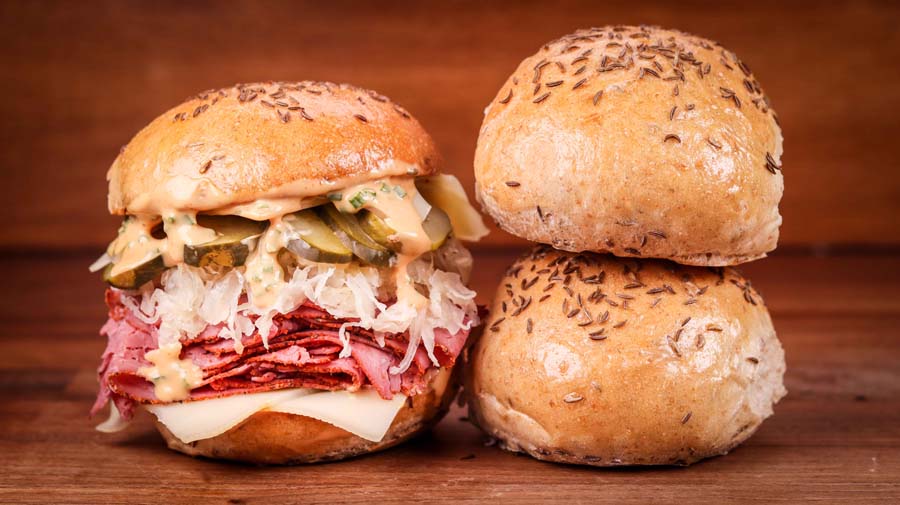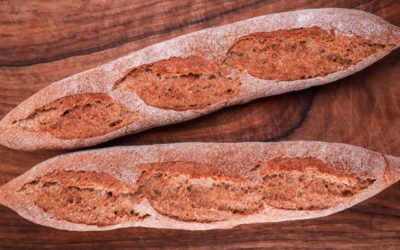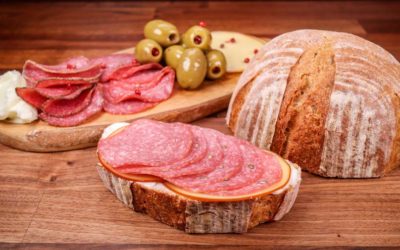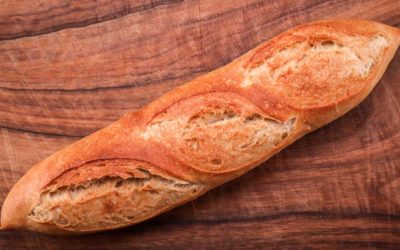These deli rye bread rolls are a great alternative to regular 100% white flour rolls.
The crumb is super soft and springy without using any fat in the dough. It is the rye flour that makes this happen because it has practically no gluten it makes the dough extensible and lets it puff up and expand more as it is rising.
You can control the texture of the crust to your liking. I used an egg wash which made it a little chewy, but you can simply spray it with water to make it crispier.
The use of a preferment gives the rolls more flavour and will extend their shelf life too. Wholemeal rye flour is best for this recipe as it has more flavour.
So, there are a few principles in this video that can be applied to many bread recipes.
This recipe yields 8 decently large buns.
Watch the video down below for detailed instructions.
Ingredients
For the preferment –
60g (2.1oz) wholemeal rye flour
Small pinch of yeast
50g (1.75oz) water at room temperature, around 22C – 24C (72F – 75F). If your kitchen is particularly cool or warm, then adjust the water temperature up or down to compensate.
For the main dough –
400g (14.1oz) strong white bread flour
9g (0.3oz) caraway seeds
9g (0.3oz) salt
6g (0.21oz) instant dry yeast or 7.2g (0.25oz) active dry yeast or 18g (0.63oz) fresh yeast
250g (8.8oz) cold water*
*To learn more about dough temperature control click here.
To top –
1 egg for glazing, whisked
Caraway seeds to sprinkle on top
For the sandwich filling –
Pastrami
Swiss cheese
Gherkins
Sauerkraut
Russian dressing –
1 part Worcestershire sauce
3 parts yellow mustard
6 parts mayonnaise
6 parts ketchup
Chopped chives
Method
- Make the preferment. In a bowl combine the water, pinch of yeast, and rye flour. Mix until no dry flour left. Cover and ferment for 12 – 16 hours or until puffed up and full of gas. If you are not ready to bake yet by the time the preferment has risen, then place it in your fridge to slow down fermentation. This is also a great way of controlling the final dough temperature if your kitchen is particularly warm as the preferment will bring the dough temperature down. To learn more about dough temperature control when using a preferment click here.
- Make the dough. In a large bowl combine the water, yeast, salt, and caraway seeds. Mix well to dissolve the salt and hydrate the yeast. Add the white flour and mix until no dry flour left.
- Tip the dough out on your table and knead for 3 minutes to get some gluten going. After 3 minutes stretch the dough out and add the preferment. Fold it in and continue kneading for 4 more minutes. *Desired dough temperature 24C – 25C (75F – 77F). If your dough is warmer, then it will ferment more rapidly. If it is cooler, then it will take longer. Adjust proofing time accordingly.
- Cover and ferment for 1 hour.
- Fold.
- Ferment for 1 more hour.
- Divide into 8 equal pieces and pre-shape into round balls.
- Dust with flour, cover and rest for 20 minutes.
- Final shape. Place the dough balls on a non-stick paper lined tray, dust them with flour and cover with cling film.
- Final proof 1 – 1.5 hours depending on the temperature of your kitchen. They should double in size. *During this time preheat your oven to 160C (320F) fan on.
- Gently brush the rolls with egg and sprinkle them with caraway seeds. Press them in lightly with the palms of your hands to really make them stick.
- Bake for 25 minutes. Turn the tray around halfway through the bake to get a nice and even crust.
- Leave to cool
To make the sandwich toast the buns in butter, fill em’ up and tuck in!
Keep in mind that the conditions in each kitchen are different, so fermentation times may vary for you. It is up to the baker to control the bread and react accordingly.
Your oven may be different too, so your baking time may vary.
Watch the video here



